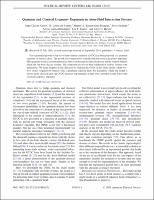Please use this identifier to cite or link to this item:
https://hdl.handle.net/20.500.12202/6450| Title: | Quantum and classical lyapunov exponents in atom-field interaction systems |
| Authors: | Santos, Lea F. Chávez-Carlos, Jorge López-del-Carpio, B. Bastarrachea-Magnani, Miguel A. Stránský, Pavel Lerma-Hernández, Sergio Hirsch, Jorge G. 0000-0001-9400-2709 |
| Keywords: | Quantum quench Quantum chaotic transport quantum chaos Quantum statistical mechanics Quantum-to-classical transition Quantum chaotic systems quantum billiards General Physics Quantum Information Condensed Matter & Materials Physics |
| Issue Date: | 15-Jan-2019 |
| Publisher: | American Physical Society |
| Citation: | Santos, Lea F., Jorge Chávez-Carlos, B López-del-Carpio, Miguel A Bastarrachea-Magnani, Pavel Stránský, Sergio Lerma-Hernández, Jorge G Hirsch. (2019). Physical Review Letters 122(2): 021401. |
| Series/Report no.: | Physical Review Letters;122(2) |
| Abstract: | The exponential growth of the out-of-time-ordered correlator (OTOC) has been proposed as a quantum signature of classical chaos. The growth rate is expected to coincide with the classical Lyapunov exponent. This quantum-classical correspondence has been corroborated for the kicked rotor and the stadium billiard, which are one-body chaotic systems. The conjecture has not yet been validated for realistic systems with interactions. We make progress in this direction by studying the OTOC in the Dicke model, where two-level atoms cooperatively interact with a quantized radiation field. For parameters where the model is chaotic in the classical limit, the OTOC increases exponentially in time with a rate that closely follows the classical Lyapunov exponent. |
| Description: | Research article, peer-review. Open Access. |
| URI: | https://doi.org/10.1103/PhysRevLett.122.024101 https://hdl.handle.net/20.500.12202/6450 |
| ISSN: | Print: 0031-9007 Electronic: 1079-7114 |
| Appears in Collections: | Stern College for Women -- Faculty Publications |
Files in This Item:
| File | Description | Size | Format | |
|---|---|---|---|---|
| Santos Quantum and Classical 2019 OA PhysRevLett.122.024101.pdf | 281.73 kB | Adobe PDF |  View/Open |
This item is licensed under a Creative Commons License

